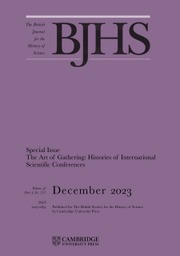As a teacher–scholar at a primarily undergraduate university, I aim to assign accessible, thought-provoking, and well-researched texts to my students. The second edition of Anita Guerrini's Experimenting with Humans and Animals ably meets these three requirements. She surveys experiments performed in Europe from roughly 350 BCE to the twentieth century and in America from the nineteenth century to the present. In doing so, she asks readers to consider how this long history might inform policy debates over the role of human and animal experimentation in science education and biomedical studies after COVID.
This book has many strengths. It discusses some of the triumphs and tragedies of this type of experimental research and provides examples of medical studies performed on prisoners, enslaved peoples and non-human mammals, including dogs and primates. As with the first edition, this book does not shy away from discussing the violence and cruelty inherent in these experiments, especially in the pre-anaesthesia era, but crucially it does not sensationalize this research. Rather, it approaches the subject with care. The first chapter, however, continues to be the book's Achilles heel.
This book focuses on ‘Western-style science’ (p. 1), but whether one can categorize premodern studies of the natural world as ‘Western’ or ‘Western-style’ is debatable. Beginning in the ancient Mediterranean, Chapter 1, ‘Bodies of evidence’, recounts the tensions between empirics, who emphasized the importance of observing symptoms when making medical diagnoses, and dogmatists, who stressed the relevance of anatomy to medical practice. It skilfully describes some of the anatomical and physiological studies conducted by Aristotle, Herophilus, Erasistratus and Galen, and concludes with a discussion of medieval Christians’ views of animals. It neglects, however, the important contributions of Islamic scholars to the study of anatomy and physiology, as well as their critical role in the translation movement. Arguably, there would be no ‘Western science’ without their efforts.
This concern aside, the next two chapters fast-forward to early modern Europe and explore the role of vivisection in medical research. Chapter 2, ‘Animals, machines, and morals’, focuses on William Harvey's experiments on the motion of the heart and blood in animals and the so-called Cartesian ‘beast-machine’ and its moral implications for animal pain and suffering. Chapter 3, ‘Disrupting God's plan’, examines the history of smallpox inoculations and the burgeoning role of medical statistics in determining the efficacy of inoculations in preventing serious illness and death. This chapter also provides interesting examples of growing public awareness of and concern with vivisection in eighteenth-century Britain, especially with experiments performed on dogs and horses. From Irish satirist Jonathan Swift's Gulliver's Travels to English philosopher Jeremy Bentham's early advocacy for animal rights, it sets the stage for the next three chapters, which survey public disputes between antivivisectionists and medical researchers in the nineteenth and twentieth centuries.
More specifically, Chapter 4, ‘Cruelty and kindness’, highlights the rise of animal welfare legislation, the development and use of anaesthesia and debates over human and animal experimentation, especially in Britain and France. Prior to the mid-nineteenth century, it was unclear whether these (often cruel) studies would lead to better medical diagnoses and treatments. Harvey's experiments had convinced the European medical community that blood circulates in the body, and yet physicians continued to treat fever-causing illnesses with bloodletting well into the nineteenth century. Chapter 5 on ‘The microbe hunters’, in contrast, shows how the germ theory of disease, coupled with animal experimentation, led to significant medical breakthroughs, such as the development of sulpha-drugs and rabies and diphtheria vaccines. In light of these successes, the antivivisection movement began to wane but never completely disappeared because of the high cost of these studies: ‘mice, rats, guinea pigs, dogs, cats, horses, and other animals continued to be sacrificed to provide another piece of the puzzle of human and animal disease’ (p. 122). Building on this theme, Chapter 6, ‘Polio and primates’, investigates the spread of poliomyelitis in America and the role of experiments on non-human primates in not only vaccine development but also psychological research. Because humans and monkeys have a complex and close biological relationship, these studies raised new questions about animal rights and research ethics.
Focusing on biomedical research after the Second World War, the seventh chapter, ‘From Nuremberg to CRISPR’, continues to explore some of the moral and legislative dilemmas associated with human and animal experimentation. It takes three interesting but unexpected detours along the way. It considers animal experiments in agricultural research, ecological studies and de-extinction efforts before returning to physiology, pharmacology and more recent developments in gene therapy. Because it covers so much ground (and includes the most extensive bibliography), perhaps if there is a third edition, this chapter could be split into two: one on the agricultural industry and environmental studies and one on the pharmaceutical industry and medical genetics.
No study covering three thousand years of history can be comprehensive, yet this book provides readers with an impressively diverse set of examples to consider. As with other texts in Johns Hopkins's Introductory Studies to the History of Science, it includes sidebars and endnotes. The most effective sidebars include excerpts from primary sources, which showcase the kinds of ‘data’ that historians use to construct arguments. The book also does not have a bibliography per se. Rather, each chapter has ‘Suggested further reading’. These recommendations invite readers to further explore and deepen their understanding of specific topics of interest, providing a valuable entry point into the historiography.
Overall, and despite my concerns with the first chapter, this expanded edition is a very welcome addition to the literature. As Guerrini notes, ‘animal and human experimentation are unlikely to disappear in the foreseeable future’ (p. 184), and so it behoves us to carefully weigh the benefits and costs of this research. This book is critical reading for students, teachers and scholars interested in learning more about the long history of human and animal experimentation.



